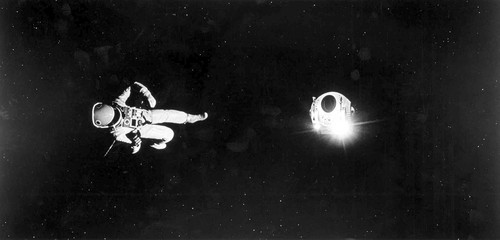space survival

Astronaut Frank Poole in 2001: A Space Odyssey.
The question is often asked: For how long could an unprotected human survive in the vacuum of space?
Following a sudden decompression to a vacuum, you could expect to remain conscious for, at most, 10 to 15 seconds. Quickly thereafter paralysis would set in, accompanied by the rapid formation of water vapor in the sift tissues, which would bloat your body to roughly twice its normal size (but not cause it to explode). Holding your breath in anticipation of decompression would be a bad move, since it would result in your lungs bursting almost instantly. Although your blood would not boil, your circulation would stop within a minute as the pressure in the venous system rose (again, due to the expansion of water vapor) until it surpassed that of the arterial system. Other health hazards of taking a spacewalk without a spacesuit, such as temperature extremes and exposure to intense ultraviolet, would not inconvenience you, as you would already be dead.
Experiments to determine the biological effect of space exposure have, unfortunately, been carried out on animals, including chimpanzees. Data concerning the specific effect on humans have come from a number of accidents. One of these occurred at the Manned Spacecraft Center (now the Johnson Space Center) when a test subject was exposed to a near-vacuum after his spacesuit sprang a leak in a vacuum chamber. He remained conscious for about 14 seconds, and later, following repressurization after being in the near-vacuum for about 30 seconds, he reported that his last memory was of the water on his tongue starting to boil. Many deaths have followed rapid decompression, mostly involving crew and passengers of high-altitude planes, but also including those of the three cosmonauts aboard Soyuz 11 in Jun 1971. However, the only known decompression incident in American spaceflight happened during Space Shuttle mission STS-37 in April 1991. In the course of the EVA, the palm restraint in one of the astronaut's gloves came loose and punched an eighth-inch hole in the pressure bladder between thumb and forefinger. In the excitement of his spacewalk, the astronaut didn't realize what had happened and only later discovered a painful red mark on his hand. His skin had partly sealed the opening and he had then bled into space until his clotting blood and had filled the rest of the gap.


